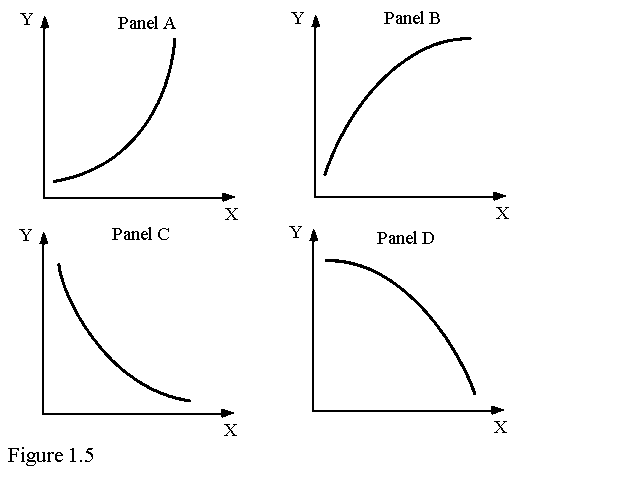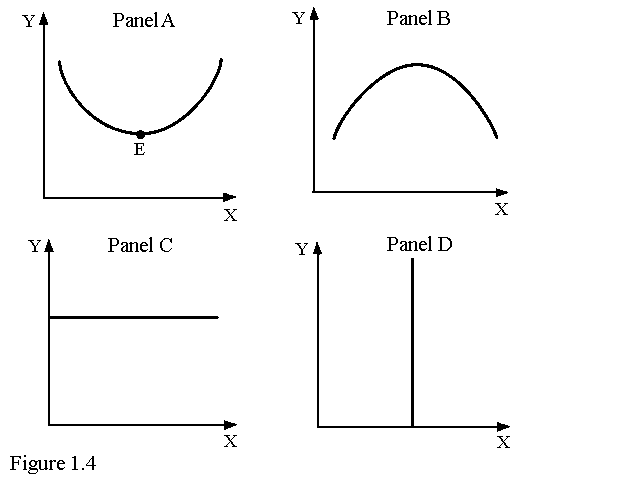
Page 1
1. The income distribution is too skewed to the rich in the United States. This statement is best described as a
a. positive statement.
b. Marxist ideology.
c. normative statement.
d. descriptive economics statement.
2. Sunk costs are
a. costs that cannot be avoided, because they have already been incurred.
b. the costs of what we give up when we make a choice or a decision.
c. the additional costs of producing an additional unit of a product.
d. the additional costs of consuming an additional unit of a product.
3. The amount of education that one has is an important factor in the determination of his or her wage rate. This statement is best described as a
a. positive statement.
b. Marxist ideology.
c. normative statement.
d. descriptive economics statement.
4. Rent control laws are imposed in a city because landlords have been exploiting tenants. This statement is an example of
a. efficiency.
b. equity.
c. growth.
d. stability.
5. A voluntary trade is made between two individuals that makes each one better off. This statement is an example of
a. efficiency.
b. equity.
c. growth.
d. stability.
6. I have lived in a house on the ocean for many years and have never seen a hurricane. Therefore, there is no reason for anyone to buy flood insurance. This statement is an example of
a. fallacy of composition.
b. post hoc, ergo propter hoc fallacy.
c. fallacy of inductive reasoning.
d. ceteris paribus fallacy.
Page 2
7. Which of the following is the best definition of economics?
a. The study of how individuals and societies choose to use the scarce resources that nature and previous generations have provided.
b. The study of how consumers spend their income.
c. The study of how business firms decide what inputs to hire and what outputs to produce.
d. The study of how the federal government allocates tax dollars.
8. The study of economics
a. is a very narrow endeavor.
b. is a way of analyzing decision-making processes caused by scarcity.
c. is concerned with proving that capitalism is better than socialism.
d. focuses on how a business should function.
9. You own a videotape of Beauty and the Beast. The opportunity cost of watching Beauty and the Beast for the second time
a. is zero.
b. is one-half the cost of the videotape, since this is the second time you have watched it.
c. is the value of the alternative use of the time you spend watching the videotape.
d. cannot be calculated.
10. A market in which profit opportunities are eliminated almost instantaneously is
a. a laissez-faire market.
b. a capitalist market.
c. a socialist market.
d. an efficient market.
11. The branch of economics that examines the functioning of individual industries and the behavior of individual decision-making units is
a. positive economics.
b. normative economics.
c. macroeconomics.
d. microeconomics.
12. Macroeconomics is the branch of economics that examines
a. the economic behavior of aggregates - income, employment, and output - on a national scale.
b. the functioning of individual industries and the behavior of individual decision-making units, that is, business firms and households.
c. ways to understand behavior and the operation of systems without making judgments.
d. outcomes of economic behavior, evaluates them as good or bad, and prescribes preferred courses of action.
Page 3
13. If you observe that Event A happens before Event B happens, and you conclude that Event A caused Event B, you would be guilty of an error called the
a. fallacy of composition.
b. fallacy of inductive reasoning.
c. fallacy of ceteris paribus.
d. post hoc, ergo propter hoc fallacy.
14. The phrase "ceteris paribus" is best expressed as
a. "all else equal."
b. "everything affects everything else."
c. "scarcity is a fact of life."
d. "there is no such thing as a free lunch."
15. The principle that irrelevant detail should be cut away is known as
a. Say's Identity.
b. ceteris paribus.
c. Ockham's razor.
d. Hobson's choice.
16. Two variables are said to be __________ if one variable changes when the other variable changes.
a. causally related.
b. correlated.
c. statistically related.
d. dependent.
17. A change in the allocation of resources is potentially efficient if
a. all individuals are made better off.
b. it at least potentially makes some people better off without making others worse off.
c. the number of people made better off is greater than the number of people made worse off.
d. the value of the resulting gains equals the value of the resulting losses.
Page 4

18. Refer to Figure 1.5. In the clothing industry, as firms produce more units of output, average costs of production decline and for each additional unit of output produced average costs of production fall by a smaller and smaller amount. If output is graphed on the horizontal axis and average costs are graphed on the vertical axis, the relationship between average costs and output would be like which of the following panels?
a. A
b. B
c. C
d. D
Page 5
19. Refer to Figure 1.5. Which of the curves has a slope that is negative and increasing?
a. A
b. B
c. C
d. D

20. Refer to Figure 1.4. Which of the curves or lines has a slope that is first positive and then negative?
a. A
b. B
c. C
d. D
Page 1
1. c
2. a
3. a
4. b
5. a
6. a
7. a
8. b
9. c
10. d
11. d
12. a
13. d
14. a
15. c
16. b
17. b
18. c
19. d
20. b